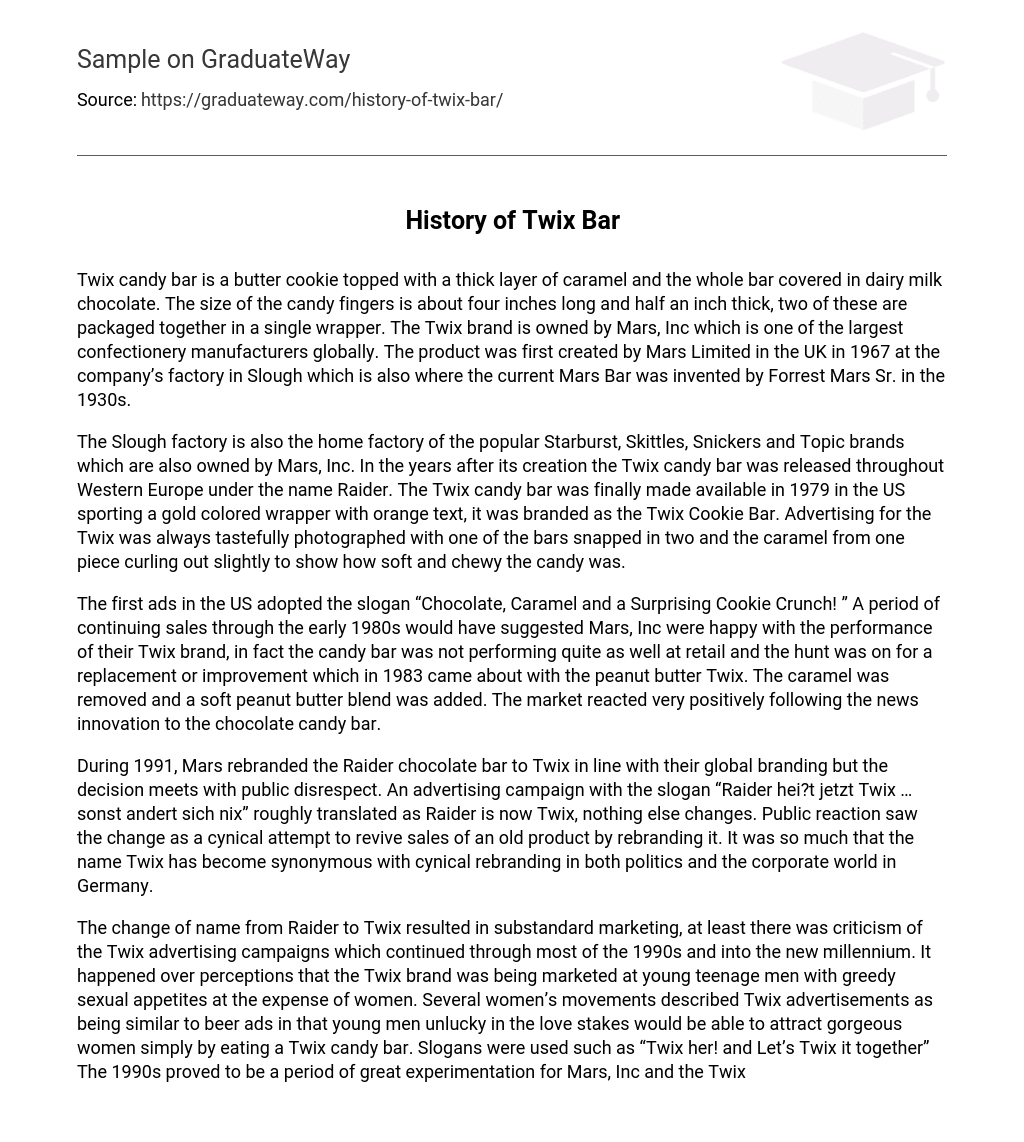The Twix candy bar consists of a butter cookie topped with a thick layer of caramel and covered in dairy milk chocolate. Each candy finger is approximately four inches long and half an inch thick. Two of these fingers are packaged together in one wrapper. The Twix brand is owned by Mars, Inc, which is one of the largest confectionery manufacturers worldwide. The product was originally created by Mars Limited in the UK in 1967 at their factory in Slough, where the current Mars Bar was also invented by Forrest Mars Sr. back in the 1930s.
The Slough factory is the home factory of popular brands owned by Mars, Inc., including Starburst, Skittles, Snickers, and Topic. In the years following its creation, the Twix candy bar, originally named Raider, was introduced in Western Europe. It wasn’t until 1979 that the Twix Cookie Bar, featuring a gold colored wrapper with orange text, became available in the US. The advertising for Twix showcased the candy’s soft and chewy texture by tastefully photographing one of the bars broken in half with the caramel slightly curling out.
The initial advertisements in the United States featured the tagline “Chocolate, Caramel and a Surprising Cookie Crunch!” Though sales remained steady until the early 1980s, Mars, Inc was not fully satisfied with the performance of their Twix brand at retail. Thus, they sought a replacement or enhancement, resulting in the introduction of peanut butter Twix in 1983. The caramel was eliminated and replaced with a smooth peanut butter blend, generating a highly favorable response from the market towards this innovative chocolate candy bar.
In 1991, Mars renamed the Raider chocolate bar to Twix as part of their global branding strategy. However, this decision was met with public disapproval. A marketing campaign with the slogan “Raider hei?t jetzt Twix … sonst andert sich nix” was launched, which translates to “Raider is now Twix, nothing else changes.” The public viewed this change as a manipulative attempt to boost sales by rebranding an old product. The impact was so significant that the term Twix has become synonymous with manipulative rebranding in both politics and the corporate world in Germany.
The rebranding of Raider to Twix caused subpar marketing. There was criticism of the Twix advertising campaigns that persisted throughout the 1990s and into the new millennium. These campaigns were accused of targeting young teenage men with insatiable sexual desires, neglecting women. Various women’s movements likened Twix advertisements to beer ads, suggesting that by eating a Twix candy bar, unlucky young men could attract attractive women effortlessly. The slogans used included “Twix her!” and “Let’s Twix it together.” Mars, Inc and the Twix brand underwent a period of extensive experimentation in the 1990s. This resulted in the introduction of numerous new varieties, some of which are still produced today. As a result, the Twix brand has become one of Mars, Inc’s leading chocolate confectionery brands globally. New flavors and varieties that were brought to market included cookies and cream, fudge, dark chocolate, white chocolate, coffee, orange flavor, mint slice, triple chocolate, and most recently Twix Java and Twix Cappuccino.
Twix was selected in the early 1990s as one of the brands to be revamped for ice cream market competition. Frozen Twix bars were introduced and sold in supermarket and mall ice cream vendor ice boxes. This move aimed to strengthen the Twix brand and overall product development for Mars, Inc. Additionally, the popularity of these individually wrapped bars increased sales of Mars branded confectionery in non-traditional markets.
In 2007, Mars, Inc in Europe stirred controversy by substituting animal rennet for whey in their Twix candy bars. This change upset vegetarians who had been loyal to Mars candy because it was previously vegetarian. The negative press and large protests led to Mars, Inc agreeing to revert back to their old recipe without animal rennet by the end of 2007. However, a whistle blower in 2008 revealed that the company was still using animal rennet despite their assurances.





